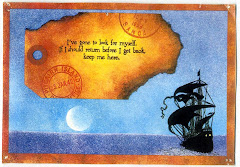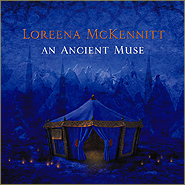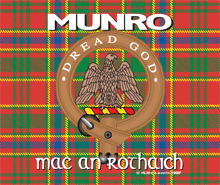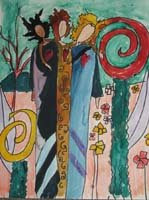
Monday, March 30, 2009
SPRING, WHAT SPRING? WHERE??

Friday, March 27, 2009
WATER, WATER, EVERYWHERE, AND NOT A DROP TO DRINK (IT'S FILTHY)


And it all happened to a river that flows north. (Yes, the Red River of the North is one of the few rivers that flows from south to north, just in case you're ever asked that question in Trivial Pursuit or Jeopardy.)
Thursday, March 26, 2009
BISMARCK FLOOD UPDATE

I want to thank everyone for their comments and e-mails of concern regarding the flooding in Bismarck. Dan and I and Gracie are fine.
I had promised an updated post last night and I'm sorry I didn't get to it. I watched the 5 p.m. news, the 6 p.m. news and the 10 p.m. news but felt too exhausted by then to write a post.
But I have good news. The flood threat here in Bismarck has lessened, for several reasons:
1. The water level has dropped by 2 feet.
2. The dynamiting of the south ice jam has been successful. They set off one round at 4:30 p.m. yesterday and one late last night. They will set off a third and final round this morning. It has gotten the water moving. Also, helicopters are dumping massive amounts of salt on the ice to dissolve it. (The ice chunks are 3 feet thick and each is about the size of a small car.)
3. The report that the north ice jam at the Double Ditch Historic Site and Recreation Area had broken yesterday morning proved to be erroneous. The news media later reported that water was running over and around the jam, but that it was holding firm for the time being. However, the updated report was too late to prevent a mini panic in Bismarck, with people rushing home to protect the property.
4. The Tuesday blizzard has left very cold air in its wake, which is a good thing! It has helped with the runoff problem. Oh, didn't I tell you that we had a blizzard? We got 8 inches of heavy wet snow with wind gusting up to 45 miles per hour.
I couldn't make it up the hill from work on Tuesday. I ended up sliding off the road and getting stuck. I was going to write a post about my awful day, but decided that a great many people around here were having way worse problems than I was.
I have been focusing on the flooding in Bismarck because I live here, but I have to tell you that a number of smaller towns in North Dakota have been deeply affected by flooding. Among the hardest hit are Hazen, Beulah, Linton, Carson and Mott. Also, farmers are suffering. A number of families had to be airlifted from their water-surrounded farms by the National Guard in Black Hawk helicopters.
Farmsteads have been turned into islands and cattle have been left stranded. It is calving season and it couldn't have happened at a worse time. One area farmer lost 50 cows and calves.
The national NBC News last night focused on Fargo, rightly so. The Red River of the North is predicted to crest in Fargo tomorrow at its highest level ever, at 41 feet. This beats the 1997 crest of 39.51 feet and the all-time record crest of 40.1 feet in 1897.
It was 1997 when the Raging Red devastated my beloved former hometown of Grand Forks, when it experienced the Flood of the Millennium. The flood changed the face of Grand Forks forever. Since then the city of Grand Forks has spent a half billion dollars to build an elaborate, state-of-the art dike system. Fargo did not. Now they are going to have their Flood of the Millennium. Thousands of volunteers are racing against time to fill sandbags and the city is scurrying to raise the dikes to 43 feet.
Please pray for the residents of Fargo and all North Dakotans. Almost every inch of the state is under a flood warning.
I had plans to show a bunch of KFYR-TV flood photos but the site is getting so many hits it is taking forever to download the photos. Instead, I will give you links to a slide show and a couple of videos.
This slideshow is from the Bismarck Tribune: http://bismarcktribune.com/shared-content/story_tools/slideshow/?type=slideshow&id=89 . It includes a great shot of a guy rescuing his two dogs from the flood. I hope you have the patience to watch the slideshow all the way to the end so you can see what an ugly, nasty thing an ice jam is.
Here is a link to a video of some people near Fargo trying to save their home. (You will recognize it from the still photo I showed yesterday of the dog surveying her flooded farmestead.) Notice how much the water has risen since the photo was taken:
http://www.startribune.com/41822192.html?elr=KArks:DCiUHc3E7_V_nDaycUiD3aPc:_Yyc:aU7DYaGEP7vDEh7P:DiUs
Wednesday, March 25, 2009
BISMARCK FLOODING
Sunday, March 22, 2009
TREAD SOFTLY BECAUSE YOU TREAD ON MY DREAMS

"TRISTAN AND ISOLDE" by John Duncan

"LADY OF SHALOTT" by William Holman Hunt
**********
HE WISHES FOR THE CLOTHS OF HEAVEN
Had I the heavens' embroidered cloths,
Enwrought with golden and silver light,
The blue and the dim and the dark cloths
Of night and light and the half-light,
I would spread the cloths under your feet:
But I, being poor, have only my dreams;
I have spread my dreams under your feet;
Tread softly because you tread on my dreams.

**********
And then, 'I am old enough';
Wherefore I threw a penny
To find out if I might love.
'Go and love, go and love, young man,
If the lady be young and fair.'
Ah, penny, brown penny, brown penny,
I am looped in the loops of her hair.
O love is the crooked thing,
There is nobody wise enough
To find out all that is in it,
For he would be thinking of love
Till the stars had run away
And the shadows eaten the moon.
Ah, penny, brown penny, brown penny,
WHEN YOU ARE OLD
When you are old and grey and full of sleep,
And nodding by the fire, take down this book,
And slowly read, and dream of the soft look
Your eyes had once, and of their shadows deep;
How many loved your moments of glad grace,
And loved your beauty with love false or true,
But one man loved the pilgrim Soul in you,
And loved the sorrows of your changing face;
And bending down beside the glowing bars,
Murmur, a little sadly, how Love fled
And paced upon the mountains overhead
And hid his face amid a crowd of stars.

TO A CHILD DANCING IN THE WIND
Dance there upon the shore;
What need have you to care
For wind or water's roar?
And tumble out your hair
That the salt drops have wet;
Being young you have not known
The fool's triumph, nor yet
Love lost as soon as won,
Nor the best labourer dead
And all the sheaves to bind.
What need have you to dread
The monstrous crying of wind!

THE WILD SWANS AT COOLE
**********
The trees are in their autumn beauty,
The woodland paths are dry,
Under the October twilight the water
Mirrors a still sky;
Upon the brimming water among the stones
Are nine and fifty swans.
The nineteenth Autumn has come upon me
Since I first made my count;
I saw, before I had well finished,
All suddenly mount
And scatter wheeling in great broken rings
Upon their clamorous wings.
I have looked upon those brilliant creatures,
And now my heart is sore.
All’s changed since I, hearing at twilight,
The first time on this shore,
The bell-beat of their wings above my head,
Trod with a lighter tread.
Unwearied still, lover by lover,
They paddle in the cold,
Companionable streams or climb the air;
Their hearts have not grown old;
Passion or conquest, wander where they will,
Attend upon them still.
But now they drift on the still water
Mysterious, beautiful;
Among what rushes will they build,
By what lake’s edge or pool
Delight men’s eyes, when I awake some day
To find they have flown away?
 (This is a photograph of the actual Isle of Innisfree)
(This is a photograph of the actual Isle of Innisfree)**********
THE LAKE ISLE OF INNISFREE
**********
I will arise and go now, and go to Innisfree,
And a small cabin build there, of clay and wattles made;
Nine bean rows will I have there, a hive for the honey bee,
And live alone in the bee-loud glade.
And I shall have some peace there, for peace comes dropping slow,
Dropping from the veils of the morning to where the cricket sings,
There midnight's all a glimmer, and noon a purple glow,
And evening full of the linnet's wings.
I will arise and go now, for always night and day
I hear lake water lapping with low sounds by the shore;
While I stand on the roadway, or on the pavements gray,
I hear it in the deep heart's core.
Thursday, March 19, 2009
SPRING EQUINOX

I couldn't believe the dozens and dozens of people who landed on my blog Tuesday, looking for the phrase "Beannachtai La Fheile Padraic Duit", which is Gaelic for "Happy St. Patrick's Day to You." They found it on a post I wrote on St. Patrick's Day two years ago.
Since then, however, I have become ambivalent about devoting a day to the man who drove the Druids out of Ireland. That's right, the Druids - not snakes, which never existed in Ireland. No, snakes are a mere symbol for the Druids and their heathen Celtic goddesses. Therefore, there was no St. Patrick's Day post from me this year. But I will say a belated but heartfelt "Slainte" to all my Irish brothers and sisters.
And, today I'm taking a break from "All Things Irish" to discuss a day sacred to ancient peoples, including the Celts. It was one of their eight holidays of the solar wheel of the year. I'm talking about the vernal - or spring - equinox, which begins at 6:44 a.m. my time tomorrow.
The Druids called this first day of spring Alban Eiler, which means, "Light of the Earth. " They considered it a rare and magical time, being one of the two days in the year that night and day are in balance. Equinoxes and solstices alike were holy times of transition for the ancient Celts, a celebration of the miraculous balance of nature and life cycles of renewal.
This is the time when the young sun god celebrates a sacred marriage with the young maiden goddess. We celebrate the return of the spring goddess from her long season of dormant sleep.

I have no photos of beautiful spring flowers or budding leaves to show you. What I do have to share are these words and the accompanying artists' interpretations of Eostre or Ostara.

Since the spring equinox is a time to celebrate fertility, and many cultures see eggs as a symbol of new life or the home of the soul, decorated eggs have been part of spring celebrations for centuries.
The egg symbolized the goddess Eostre's wholeness and fertility. (The female hormone estrogen is named after her.) The golden yolk represents the sun god; its white shell is seen as the white goddess. Eggs were offered to the earth to ensure a fecund future harvest.
Ostara or Eostre is most often seen as an older maiden or young mother figure, clothed all in white.
The vernal equinox is known as the day of equilibrium. Now is a good time to consider the balance of our lives - work, play and relationships. Perhaps for you it will be a day of quiet reflection and contemplation. Or, if you prefer, you could conduct an equinox ritual.
The following is a spring equinox ritual that is appropriate for Christians and Pagans alike. Stand outdoors at sunrise, forming a circle with those you love. Put a small tree (representing "the tree of life") or a shrub in the center of your circle, or stand around a living tree. Meditate silently together with a sense of awe and wonder about the teeming abundance of life God has created.
Sunday, March 15, 2009
AN GORTA MOR


The Great Famine - An Gorta Mór or An Drochshaol (The Bad Life) - was a period of starvation, disease and mass emigration between 1845 and 1852 during which the population of Ireland was reduced by 20 to 25 percent. Approximately one million of the population died and a million more emigrated from Ireland's shores.
The proximate cause of the famine was a potato disease commonly known as late blight. Although blight ravaged potato crops throughout Europe during the 1840s, the impact and human cost in Ireland—where a third of the population was entirely dependent on the potato for food—was exacerbated by a host of political, social and economic factors which continue to be debated today.
But there is no debate over the fact that the famine was a watershed in the history of Ireland. Its effects permanently changed the island's demographic, political and cultural landscape. For both the native Irish and those in the resulting diaspora, the famine entered folk memory and became a rallying point for various nationalist movements. Modern historians regard it as a dividing line in the Irish historical narrative, referring to the preceding period of Irish history as "pre-Famine."
I am also thoroughly convinced that the great famine was caused by greed, by stupidity and possibly even by a wish to entirely eradicate the Irish race. As I stated above, one third - ONE THIRD - of the population of Ireland was entirely dependent on the potato for food. This did not happen by accident.
Several hundred commissions and special committes inquired into the state of Ireland. Without exception their findings prophesied disaster; Ireland was on the verge of starvation, her population rapidly increasing, three-quarters of her laborers unemployed, housing conditions appalling and the standard of living unbelievably low. This was a contrast to Britain, which was beginning to enjoy the modern prosperity of the Victorian and Industrial Ages.
One commission report in 1845 stated that "It would be impossible adequately to describe the privations which they [Irish laborer and his family] habitually and silently endure . . . in many districts their only food is the potato, their only beverage water . . . their cabins are seldom a protection against the weather... a bed or a blanket is a rare luxury . . . and nearly in all their pig and a manure heap constitute their only property." The commissioners noted the "patient endurance which the labouring classes have exhibited under sufferings greater, we believe, than the people of any other country in Europe have to sustain."
Holdings became so small that ONLY potatoes—no other crop—would suffice to feed a family. Shortly before the Great Hunger, poverty was so widespread that one third of all Irish small holdings could not support their families after paying their rent, except by doing seasonal migrant labor in England and Scotland.
Ironically, the potato had been introduced to Ireland as a garden crop of the gentry. But by the first two decades of the eighteenth century, it had become a base food of the poor, especially in winter. When the blight came, in 1845, starvation came not far behind. That year, half the crop was lost. In 1846 three-quarters of the harvest was lost. The first deaths from starvation were recorded in autumn 1846.
John Mitchel, one of the leading political writers of Ireland, raised the issue of the "Potato Disease" in Ireland as early as 1844, noting how powerful an agent hunger had been in certain revolutions. In February 1846, he commented on "the wretched way in which the famine was being trifled with", and asked if the British Government even yet had any conception that there might be soon "millions of human beings in Ireland having nothing to eat."
The British reaction was to tell Irish people not to be alarmed, that learned men had been sent from England to enquire into all those matters; and that there was no "immediate pressure on the market". Sniffed The British, there was "always a tendency to exaggeration in Irish news".
Mitchel later wrote one of the first widely-circulated tracts on the famine, "The Last Conquest of Ireland (Perhaps)". It established the widespread view that the treatment of the famine by the British was a deliberate murder of the Irish, and contained the famous phrase: “The Almighty, indeed, sent the potato blight, but the English created the Famine."
(Mitchel was later convicted of treason and deported to the Bahamas.)
Thursday, March 12, 2009
PIXIES
Pixies (also piskies, pisgies, pigsies and west country fairies) are mythical creatures of folklore, considered to be particularly concentrated in the areas of Devon, Somerset and Cornwall in southern England, suggesting a Celtic origin for the belief and the name.
Though pixies and faeries seem to have much in common, and are often viewed as interchangeable, they are two distinct species. In folklore pixies and fairies are antagonists and fought a huge battle at Buckland St. Mary, Somerset. The pixies were victorious and still visit the area. The fairies are said to have left after their loss.
Some adherents find pixies to have a human origin or to “partake of human nature” in distinction to fairies whose mythology is traced to immaterial spirit forces.

"PIXIES IN THE WATER"
Pixies are said to be nearly ageless and uncommonly beautiful, though there are some called pixie who have a distorted and strange appearance. There is a debate as to whether or not pixies have wings.
Pixies are usually described as having green eyes, pointed ears and slanted eyes. In art they are often depicted wearing a green outfit and pointed hat. These are Victorian Era conventions and not part of the older mythology.

"PIXIES' GARDEN"
In fact, legend has it that pixies generally go unclothed, though they are sensitive to human need for covering. They do have a weakness for bits of finery, and a piece of ribbon appears to be highly prized by them.
In Devon, pixies are said to be “invisibly small, and harmless or friendly to man.” Others say they are no larger than a human hand but can change their size at will. In yet other legends and accounts they are presented as having near human stature.
 "PIXIE DUST"
"PIXIE DUST"There are as many discrepancies as to the origin of pixies as there are conflicting descriptions.
Some believe them to be the earliest inhabitants of England. One British scholar took pixie myth seriously enough to state his belief that “pixies were evidently a smaller race, and, from the greater obscurity of the … tales about them, I believe them to have been an earlier race.”
The pixies of Dartmoor in Devon are fond of music and dancing. They dance in the shadows of the standing stones, or gambol on the edges of tumbling stream. Their bells can be heard deep in the heart of the many tors on the moor.
Pixies bless the land. They are forest creatures whom other wild creatures find alluring and nonthreatening. They love humans, taking some for mates.
Some pixies are said to steal children or to play their favorite trick - leading humans astray. Sometimes pixies may confuse mortals so thoroughly that they never recover and wander aimlessly through the countryside singing or talking a mysterious language. This condition is known as being "pixie-led". If one felt the onset of a pixie spell, one could foil a pixie by turning their coat inside-out.

"DAYDREAM"
The term "pixie-led" has been transformed into the modern word pixilated, which has nothing to do with computer images at all but instead means: behaving as if mentally unbalanced, very eccentric, whimsical, prankish, bemused, intoxicated or drunk.
Those who deliberately follow pixies often vanish without a trace. For example, a farmhand at Rowbrook, along the River Dart, is said to have been lured down towards the river by mysterious voices, calling his name: ‘Jan Coo.’ He was never seen again.
Pixies are “great explorers familiar with the caves of the ocean, the hidden sources of the streams and the recesses of the land.” Some are said to exude pixie dust, which is left in their footprints.
Pixies can be repelled by objects made from silver as contact with the metal can harm them, another trait they share in common with the fairies of the British Isles.
Farmers can stay in good terms with pixies by leaving buckets of water out at night for pixie mothers to wash their babies, leaving out a pitcher of milk for them to drink, and keeping the hearth swept clean for pixies to dance on at midnight.
Before the mid 19th Century pixies and fairies were taken seriously in much of Cornwall and Devon. Books devoted to the homely beliefs of the peasantry are filled with incidents of pixie manifestations.
However, in some regions, belief in pixies has endured into contemporary times. During the construction of Hinkley Point nuclear power station, anything that went wrong was blamed on "the Pixy," with the station being built near Wick's Barrow, an Iron Age burial mound called "Pixies Mound" by the locals.
As for me, I hope there are still pixies around, just not the mischievous ones!
By Samuel Minturn Peck
‘Tis said their forms are tiny,
yet all human ills they can subdue,
Or with a wand or amulet
Can win a maiden’s heart for you;
To make to wedlock bright;
The Pixies are abroad tonight."
**********
By Nora Chesson
Have e’er you seen the Pixies, the folk not blest or banned?
They walk upon the waters; they sail upon the land,
They make the green grass greener where’er their footsteps fall,
The wildest hind in the forest comes at their call.
The steal from bolted linneys, they milk the key at grass,
The maids are kissed a-milking, and no one hears them pass.
They flit from byre to stable and ride unbroken foals,
They seek out human lovers to win them souls.
The Pixies know no sorrow, the Pixies feel no fear,
They take no care for harvest or seed time of the year;
Age lays no finger on them, the reaper time goes by
The Pixies, they who change not, grow old or die.
The Pixies though they love us, behold us pass away,
And are not sad for flowers they gathered yesterday,
To-day has crimson foxglove; if purple hose-in-hose
Withered last night, tomorrow will have its rose."


































































